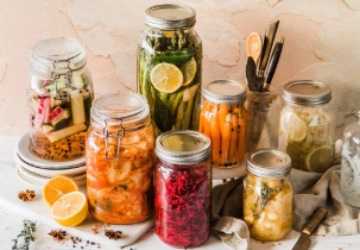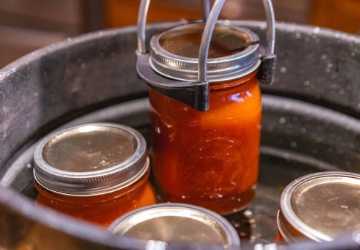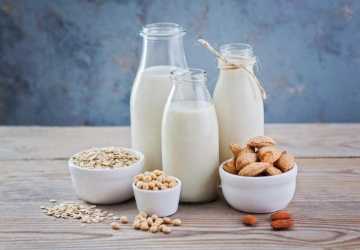The Most Common Food Preserving Mistakes and How to Avoid Them
Even the most experienced canners occasionally make mistakes when preserving food. Ensuring safe food preservation at home depends on recognizing the ever-present pitfalls and knowing how to avoid them. This guide explains common problems and provides practical remedies.
Even the most experienced canners occasionally make mistakes when preserving food. Ensuring safe food preservation at home depends on recognizing the ever-present pitfalls and knowing how to avoid them. This guide explains common problems and provides practical remedies.
Inadequate Sterilization of Jars
Inadequate sterilization of jars is a common mistake in food preservation. This step is essential to ensuring the safety of preserved foods.
How to Avoid:
- Always start with pristine, heated glass.
- Sterilize the jars in boiling water for at least 10 minutes.
- Use a sterile, dry cloth to handle the jars to avoid contamination.
Inaccurate Processing Times
Another common mistake is the failure to maintain accurate processing times. This can result in under-processing of food, which can be dangerous.
How to Avoid:
- Stick to reliable recipes that provide accurate processing times. - Use a chronometer to ensure the correct duration.
- If necessary, adjust processing times for altitude.

Neglecting to Vent the Pressure Canner
Proper venting of a pressure canner is essential to remove air and achieve the correct pressure.
How to Avoid:
- Follow the manufacturer's instructions for venting the canner.
- Allow steam to escape for at least 10 minutes before sealing.
- Check pressure throughout the process.
Using Poor Quality Produce
Using bruised or overripe produce can compromise the quality and safety of your preserved foods.
How to Avoid:
- Choose fresh, quality produce for preservation.
- Discard any fruit or vegetable that shows signs of spoilage.
- Rinse carefully before use.
Improper Storage Conditions
Storing preserved foods under incorrect conditions can lead to spoilage or foodborne illness.
How to Avoid:
- Store jars in a cool, dry environment to avoid preservation errors.
- Avoid storage near heat sources or in direct sunlight.
- Check seals regularly to ensure safe preservation of food at home.
Ignoring the Cooling Process
Properly cooling jars after processing is an often overlooked step in safely preserving food at home.
How to Avoid:
- After processing, cool the jars on a towel or rack.
- Allow them to cool undisturbed for 12-24 hours.
- After cooling, check seals and re-process or refrigerate any unsealed jars.
Neglecting to Label Jars
Failure to label jars can cause confusion between contents and processing dates, making shelf life difficult to track.
How to Avoid:
- Label jars with contents and save-by date.
- Use waterproof labels or markers.
- Organize jars by date, with the oldest first.
Overfilling or Underfilling Jars
Incorrect filling amounts can cause jars to not seal properly or spoil.
How to Avoid:
- Leave the recommended space as directed in the recipe.
- Wipe the edges clean before sealing.
- Make sure the lid is centered and the ring is installed with the correct tension.
Highly Acidic Foods Should Not Be Processed in a Boiling Water Bath
Highly acidic foods such as fruits and pickles require a boiling water bath for safety reasons.
How to Avoid:
- Process highly acidic foods in a boiling water bath for the time specified in the recipe.
- Use a pot deep enough to cover the jars with at least an inch of water.
- Start timing as soon as the water returns to a vigorous boil.
Using Outdated or Unreliable Recipes
Using outdated or unverified recipes can lead to food preservation errors that compromise safety.
How to Avoid:
- Use current, verified recipes from reliable sources.
- Avoid improvisation or changes in recipes, especially in terms of processing time or ingredients.
- Consult trusted manuals or websites to ensure safe food preservation at home.
Using Incorrect Equipment
Using inappropriate equipment can lead to serious food preservation errors that compromise safety and integrity.
How to Avoid:
- Use equipment specifically designed for food preservation.
- Ensure all equipment is in top working condition and carefully calibrated.
- Replace any worn or defective instruments immediately.
Importance of pH is Overlooked
Failure to measure food pH can lead to dangerous preservation operations.
How to Avoid:
- Use a pH indicator or meter to determine the acidity of a food.
- Follow recipes that specify a precise pH for preservation.
- Add an acidifier such as citric or acetic acid to adjust pH as needed.
Failure to Follow Hygiene Regulations
Failure to follow strict hygiene regulations can introduce contaminants into your preserved foods, which can lead to spoilage or illness.
How to Avoid:
- Keep your workspace spotless, including work surfaces, utensils and hands.
- Sanitize all equipment and surfaces beforehand. Avoid preservation errors.
- Keep raw and preserved foods separate to prevent cross contamination.
Using Inappropriate Sealants
Poorly sealed jars can allow air and microorganisms to enter, leading to spoilage.
How to Avoid:
- Use new, undamaged lids and bands for each preservation.
- Make sure lids are centered and the tension of the mounting rings is correct.
- Check the seal after cooling and re-process any poorly sealed jars.
Misunderstanding of Water Activity
Failure to regulate water activity in preserved foods can lead to microbial proliferation and spoilage.
How to Avoid:
- Understand the concept of water activity and its importance in food preservation.
- Use drying methods, salt and sugar to regulate water activity in preserved foods and avoid preservation errors.
- Follow guidelines for establishing appropriate water activity levels for various preserved foods.
Recipes That Are Too Complicated
Including unnecessary steps or ingredients can lead to dangers and mistakes in food preservation.
How to Avoid:
- Stick to simple, proven recipes that you know how to use.
- Avoid improvisation or adding unnecessary steps that are not recommended.
- Focus on mastering basic techniques before attempting more complex recipes.
Neglecting to Preheat Canning Lids
Failure to preheat canning lids can result in an inadequate seal.
How to Avoid:
- Heat canning lids in boiling water according to the manufacturer's instructions.
- Avoid boiling lids, as this may compromise the seal.
- Put lids on while hot to ensure a good seal.

Neglecting to Ventilate the Storage Area
How to Avoid:
- Keep the storage area well ventilated to prevent moisture buildup.
- Do not store glasses in damp or enclosed rooms.
- Regularly inspect the storage area for signs of mold or moisture and correct problems promptly to avoid preserving errors.
Conclusion
Avoiding preserving errors is essential to the safety and quality of preserved foods. By following these guidelines, you can safely preserve foods at home and enjoy the fruits of your labor for months to come. Remember, careful attention to detail and adherence to proper techniques are essential to avoiding preserving errors and ensuring your preserved foods remain safe and delicious.





